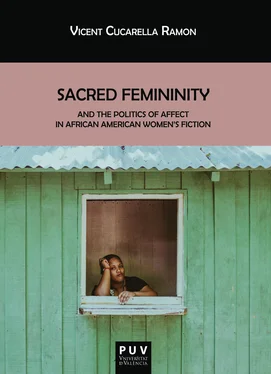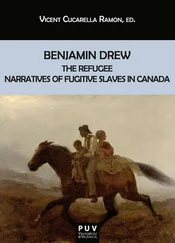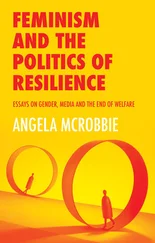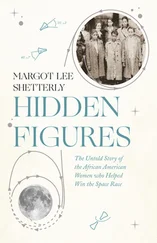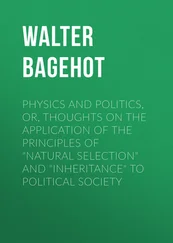The merging of religion and affect allowed these writers to rethink the configuration of new forms of black cultural appropriation in the US. This is so because, as Gregory J. Seigworth and Melissa Gregg remind us, affect “can serve to drive us toward movement, toward thought and extension” (1). In this sense, Crafts, Hurston and Morrison transform affect into an “ethical, aesthetic, and political task all at once” (Seigworth & Gregg 3).
If a sociopolitical reading of the politics of affect can easily bridge the distance between reason and emotions, the use of affect in the hands of these black women writers brings to the fore another interpretation to spirituality that goes beyond the supposed gulf between emotion and reason and, eventually, proposes to read it as an optional type of rational belief. Affect, then, appears as a concept practiced by black women also in their constant help for self-assertion. The affective turn that they apply either to or against their sacred reading of Christianity points out to autonomy and self-representation through creativity. As Lloyd further proclaims,
The most important upshot of the feminist critique of rationality has perhaps not been the emergence of – or even the aspiration to – a thought-style that is distinctively ‘female’. Perhaps it has been rather a sharper articulation of the different strands – intellectual, imaginative, and affective – involved in human ways of thinking; a resistance to their polarization; and a greater appreciation of the strength and limitations of different ways of bringing them together. Different kinds of unity between intellect, imagination and emotion are appropriate. (172)
Hence, and despite its manifold manifestations and the “sweeping assortment of philosophical/psychological/physiological underpinnings…and ontological pathways”, the concept of affect is used by these black women writers in “all manner of political/pragmatic/performative ends” (Seigworth & Gregg 5, emphasis added). Such a performative mode of the affective reading of the sacred message manifests an interest in a powerful alternative to the social and cultural injustice African American women had to confront.
This is all the more revealed if we take into account how, according to Virginia Held, “the ethics of care … characteristically sees persons as relational and interdependence, morally and epistemologically” (Held 13). Thomas B. Lawrence and Sally Maitlis explain that “feminist writing sees care as an ongoing central dimension of relationships, regardless of the suffering or the flourishing being experienced” (642). Thus, these writers create an ‘ontology of possibility’ (Bloch) that links religion and affect to foster an overarching feminist mode of representing spirituality as an act of healing and growth.
The result is the creation of a sacred black female self that is positioned at the intersection of resistance, counterattack and progress. A position that takes as its central field the cultivation of affect between African American women and their encompassing social reality. The modulation of these bonds into a textual affect turns out to be a “rich site for considering how argumentative rhetorics create authority” (19), as Barbara Tomilson rightly notes. I consider the use of the word rhetoric altogether propitious because if rhetoric “refers to the use of speech or writing to persuade” (Tomilson 21), the textual affect that these three authors advance in their writings unavoidably tries to inform readers of their own cosmology.
In such a way, Crafts, Hurston and Morrison attain authoritative voice which, in their work, ceases to be regarded as a teleological process, in Foucault’s vision, and instead it comes forth as “the reversal of a relationship of forces, the usurpation of power, the appropriation of a vocabulary turned against those who had once used it, a feeble domination that poisons itself as it grows lax, the entry of a masked ‘other’” (Foucault 154-155). In other words, and following the Foucaultian theory, these authors’s readings disclaim the traditional conception of history. Rather, they fictionalize their own conception of spirituality with the grammar of affect to showcase the capacity of African American women to create and offer their own herstory . Or else, to give evidence of their aforementioned (cultural) power. Moreover, through the use of the affective mode in which these black writers model the religious discourse, Crafts, Hurston and Morrison fully embrace the import of communities of belonging. Thus, they not only aestheticize religion but they also make it appear infused with affect to prove their power and capacity to “elaborate different and alternative modalities of belonging, connectivity, and intimacy” (puar 208). In so doing, as José Esteban Muñoz asserts, affect, appears always within signification, within narrative, functioning as a form of critical resistance to dominant modes of being and becoming (2000, 67-79).
In tune with that idea, Anthony B. Pinn claims that, for black women, the creation of a genuine “(a)esthetics became a source of dominance without betraying anything of its illusionary disinterestedness. Rather, it formed and justified a particular experience of the world” (6). African American women’s aesthetics takes as a starting point the construction of a disruptive history as a resource for the present. Yet, and veering away from reductive analysis that can only read black women’s effort to evolve as a social and/or class fight, these writers have drawn on spirituality not only to reconstruct their identity in North America but also to set the pace for a feminist African American aesthetic canon. The search for a spiritual wholeness that can grant them a personal growth understood in terms of a collective achievement is a major cultural feat that black women have willingly accomplished. As Silvia Castro-Borrego rightly contends, for African American women “Ancestral Spiritualism consists of the connection among the past, present and future, and the life force that makes it possible for the physical and the spiritual worlds to be done” (9). To these words I would add that such a life force is based on the use of the Christian religion that Crafts, Hurston and Morrison have tried to recast as a sign of their own cultural outlet. Thus, their spirituality is directly linked to a certain idea of religion that black women got together as a central site for the creation of a unique aesthetic.
For these three writers affect is an inclusionary attempt towards national healing and, since it builds upon spirituality, it echoes in the Levinasian idea of the essence, through which they aestheticize their subjectivity, thus linking affective bonds and self-assertion. According to the French philosopher, “(t)he responsibility for the other is the locus in which is situated the null-site of subjectivity” (10). Hence, the essence of the sacredness that these black women enact is based on feminist and feminine concepts such as vulnerability, sensibility but also resilience. The sacred self that they reshape is thereby inclusive, and serves as a national expiation for the infamous outcomes of slavery. The subjectivity that these African American women writers conceive follow, thus, Levinas’ own words:
Vulnerability, exposure to outrage, to wounding…passivity of the accusative form… implicating the identity of the hostage who substitutes himself for the others: all this is the self, a defecting or defeat of the ego’s identity. And this, pushed to the limit, is sensibility, sensibility as the subjectivity of the subject. It is a substitution for another, one in the place of another, expiation. (15)
The ethics and aesthetics that revolve around the essence of this sacred femininity created by Crafts, Hurston and Morrison, are envisioned to resist essentialist notions of black feminism—or womanism, as coined by Alice Walker in the 20th century—and are crucial to understand their literary production. However, the evolution of the African American jeremiad as the central tenet for the unfolding of such spirituality—explained above—is to little avail for Toni Morrison in A Mercy .
Читать дальше
